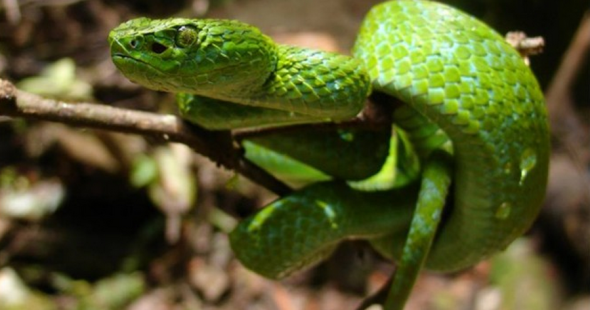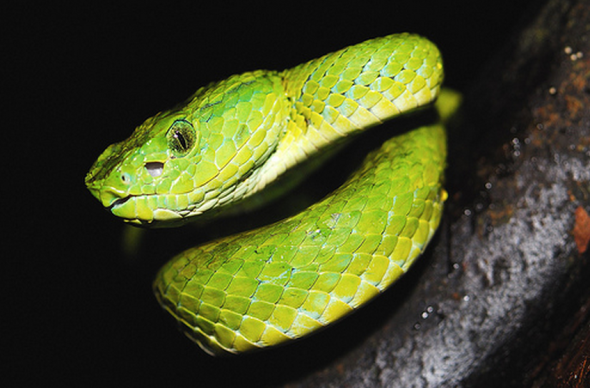Endangered Species Friday: Bothriechis marchi
Endangered Species Friday: Bothriechis marchi
This Fridays endangered species watch post (ESP) I focus ones attention on reptilians which I rarely do speak or document about. Awareness surrounding this stunning Pit Viper needs creating rather quickly, before populations go extinct. (Image credits: Dr. Silviu Petrovan B. marchi)
Endemic to Honduras (mainland) and scientifically identified as Bothriechis marchi the specie is listed as [endangered] of which populations are declining quite extensively throughout its entire range. B. marchi was identified by two environmental scientists that I’ve listed below;
1. Dr Thomas Barbour (August 19, 1884 – January 8, 1946) whom was an American herpetologist. From 1927 until 1946, he was director of the Museum of Comparative Zoology founded in 1859 by Louis Agassiz at Harvard University in Cambridge, Massachusetts. Dr Barbour identified B. marchi back in 1929.
2. Dr Arthur Loveridge (1891-1980) whom was a British biologist and herpetologist who wrote about animals in East Africa, particularly Tanzania, and New Guinea. He gave scientific names to several gecko species in the region. Dr Loveridge identified with Dr Barbour, B. marchi back in 1929.
The species was known to be quite common throughout its entire range from the mid 1980’s right-through to the early millennium. Since last observations took place around 2000 there has been few sightings of the species due to increasing threats on the mainland.
Commonly known to the locals as the Honduran Palm Pit Viper or March’s Palm Pit Viper the species is known to occur within Northern Honduras of which extends into Eastern Guatemala. Range has been reported to be some 500m to 1,500 (m) in elevation however the species is considered rare at anything below 900 (m). There have been few reports of specimens recorded below the 900 (m) elevation in Nicaragua by Villa 1984. Furthermore a few individual specimens have also been recorded at sea level.
While there are an assortment of threats that indeed pose a risk to the species the main primary reason B. marchi qualifies for the endangered listing is due to the very small locations that the species is known to inhabit. From previews records we know the species now only exists at some five to six locations of which any-form of habitat fragmentation or destruction could/would lead to species into extinction.
Even throughout the species very small range habitat loss, collapse of prey populations, and extraction for the pet trade still occurs despite the March’s Palm Pit Viper listed as endangered and, protected. One can normally locate the species next to running streams, water courses or within closed intact rain forest. To date there are no sub-species known and one must also point out the March’s Palm Pit Viper is indeed (venomous). Diet normally consists of frogs, newts, and rodents.
Image: Honduran Palm Pit Viper. (Photographer unknown).
Listed on Cites Appendix II there remains very little conservation projects in place to actually preserve the species despite Cites stating pet trade must be [regulated]. If anything there should be no pet trade and the Government of Honduras now needs to implement tough policies and regulations to ensure species survival for future generations to come. Cites in my own opinion needs to pull their finger out and restore a little faith back into the public domain as clearly very little if any monetary income is being made from the pet trade that is helping sustain conservation projects within the species range.
Threats
One of my own major concerns here on the mainland and Honduras islands is deforestation. Many of you or may not be aware, some months back we ran a conservation project on the Honduras White Bat of which deforestation was primarily to blame for the bats decreasing populations. Unfortunately the same threat also applies to the March’s Palm Pit Viper (which I find very worrying).
Timber extraction and habitat destruction is increasing on the mainland at an alarming rate placing the March’s Palm Pit Viper in danger furthermore. This species is also threatened by extraction for the pet trade. For example the Honduras authorities have issued permits for exportation of hundreds of individuals annually. Furthermore, the crash in amphibian populations threatens this species.
I must also point out that while timber extraction is placing increasing pressure on many species of fauna and flora illegal and unregulated logging remains an ever-increasing threat to sustainable development programs. Who’s to blame for this illegal logging crisis? United States and Europe have been exposed in many environmental investigation projects, timer extraction projects also increase poverty, fuel corruption not forgetting devastating communities throughout the mainland and islands. Although some actions have been taken to decrease illegal logging threats - they still very much remain and as such will push the Honduran Palm Pit Viper into extinction should measures not be implemented to protect wildlife immediately..
Please note that while there has been some-speculation there may well be a new sub-species, Bothriechis guifarroi is not related to B marchi, although near threatened the species is still pretty remarkable.
Sadly we don’t have a video for you to view the Honduran Palm Pit Viper however I’ve included a Viper video that you may enjoy.
- Have a nice day.
Thank you for reading.
Chief Environmental Officer. (Executive Director)
Dr Jose C. Depre
International Animal Rescue Foundation Africa.
Rate this:
July 31, 2015 | Categories: You must be the change you want to see in the world | Tags: Bothriechis guifarroi, Bothriechis marchi, Cites, Cites Appendix II, deforestation, Dr Thomas Barbour, Dr. Silviu Petrovan, Eastern Guatemala, Endangered, Extinction, Extraction, Friday, Fridays Animal, habitat destruction, Honduran, Honduras, Honduras White Bat, IARF, International Animal Rescue Foundation Brazil, Jose Depre, March's Palm Pit Viper, Nicaragua, Northern Honduras, Palm Pit Viper, Pet trade, Reptile, Snake, sustainable development programs, Timber, Viper. Honduran Palm Pit Viper | Leave a comment




